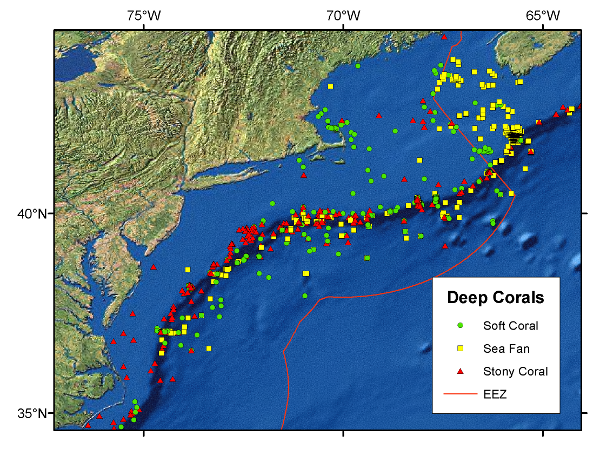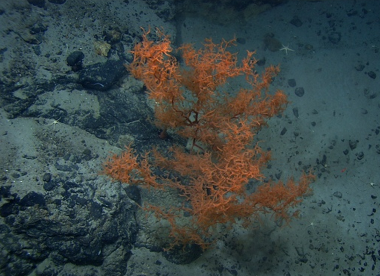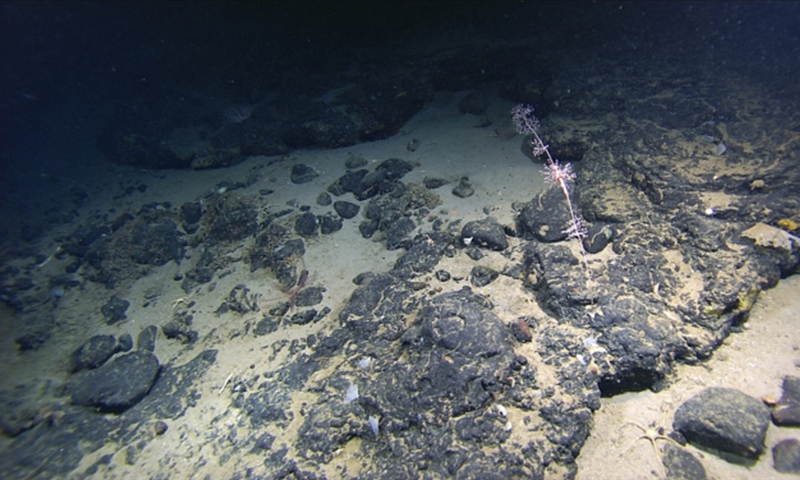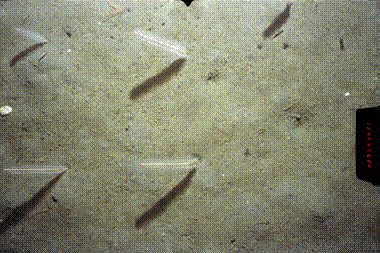Ecology of the Northeast US Continental Shelf
Deep Corals

Deep corals are living members of some benthic communities, but are also structural elements. There are no known coral reefs in northeastern U.S. waters. However, various growth forms of coral do afford some spatial complexity to habitat spaces in the region in both shallow and deep water. Corals are not unique in this regard; sponges, hydroids, anemones (solitary and colonial, fixed and burrowing), oysters, mussels, jingle shells, and tube-building worms and amphipods serve similar functions in habitats where they occur, often defining the character of the benthic community and providing cover for resident and transient fishes. Deep corals are suspension feeders, but unlike most tropical and subtropical corals, do not require sunlight and do not have symbiotic algae (zooxanthellae) to meet their energy needs. Deep corals can be found from near the surface to 6000 m depth, but most commonly occur between 50-1000 m on hard substrate, hence their “deep-sea” appellation.
Deep corals in the northeastern U.S. belong to three major groups. There are the Hexacorals (or Zoantharia), which include the hard or stony corals (Scleractinia); the Ceriantipatharians which includes the black and thorny corals (Antipatharia), and finally there are the Octocorals (or Alcyonaria), with flexible, partly organic skeletons that include the true soft corals (Alcyonacea), gorgonians (Gorgonacea or sea fans and sea whips), and sea pens (Pennatulacea). Scleractinians identified in the northeastern U.S. number 16 species, Anitpatharians number possibly 4 or perhaps more species, Alcyonaceans number 9 species, Gorgonaceans number 21 species, and Pennatulaceans number 21 species. Among all three groups, there appear to be a suite of species that occurs at depths of less than 500 m (shelf and upper slope), and a separate suite that occurs at depths greater than 500 m (lower slope and rise). One species of hard coral and one alcyonacean occur in water less than 50 m deep.
Dr. Barbara Hecker and her colleagues surveyed the deep corals of the continental margin and several submarine canyons off the northeastern U.S. in the 1980s via submersible and towed camera sled. Corals were denser and more diverse in the canyons, and some species, such as those restricted to hard substrates, were found only in canyons while the soft substrate types were found both in canyons and on the continental slope. On the shelf, with the exception of sea pens, they appear to be mostly restricted to hard substrates. Recent expeditions by researchers to the New England Seamount chain have shown that deep corals are one of the dominant members of the epifaunal communities found on the seamounts.
Distribution
Stony Corals
Most of the stony corals in this region are solitary organisms and one species, Astrangia poculata, can occur in very shallow water, at depths of only a few meters. Like its tropical relatives, it often contains symbiotic algae that assist its nutritional needs. There appears to be a general lack of stony corals on Georges Bank, but note their presence along the continental margin down to Cape Hatteras (Figure 1). They are often found on soft substrates (Figure 2). Several species of solitary and colonial stony corals also occur on Bear Seamount; one notable solitary species, Vaughanella margaritata, represents the first record of this species since its original description over 100 years ago, and is endemic to the northwest Atlantic. Other recent expeditions to the New England Seamounts have also found stony corals.
Black Corals
Antipatharians are predominantly tropical, but some species are known to occur of the northeastern U.S. Several species have been collected from the seamounts. Among those black corals that have been positively identified from the four seamounts within the EEZ to date include Bathypathes from Bear (1195–1402 and 1843–1888 m) and Retriever (1983 m) and Parantipathes from Retriever (2045 m). Bushy black coral (Leiopathes sp.) has been collected from 1643 m on Bear Seamount (Figure 3); it is also found in the collections of the Smithsonian Institution, having been collected in 1883 from 1754 m near the same area off Georges Bank. Another black coral, Cirrhipathes sp., is also found in the Smithsonian Institution collections, and was also collected in 1883 at 262 m off Virginia.
True Soft Corals and Gorgonians
Seventeen species in seven gorgonian families were recorded for the northeastern U.S. shelf and slope north of Cape Hatteras. These families (Acanthogorgiidae, Paramuriceidae, Anthothelidae, Paragorgiidae, Chrysogorgiidae, Primnoidae, and Isiddae) are the best documented because of their larger sizes, as well as being most abundant in the deeper waters of the continental slope and submarine canyons. Nine species of true soft corals in three families were recorded for the northeastern U.S. shelf and slope north of Cape Hatteras. Two species that are very numerous in nearshore records are the true soft corals Gersemia rubiformis and Alcyonium species. It should be noted that, for a variety of reasons, there is uncertainty about the accuracy of the identifications of species from these two orders from the various historical surveys, so these identifications and surveys should be interpreted with caution.
Older surveys found that both gorgonians and true soft corals were present along the outer margin of the continental shelf and on the slope and rise, and were sparse and patchy in all areas, particularly in the northern section. They were not collected in samples taken at < 50 m in depth, and were most abundant between 200-500 m. Identified species include gorgonians such as Acanella sp., Paragorgia arborea, and Primnoa resedaeformis and the true soft coral Alcyonium sp. Gorgonians and true soft corals were collected from gravel and rocky outcrops.
A survey of deep coral databases noted two distinct distributional patterns for the gorgonians and true soft corals in this region. Most are deepwater species that occur at depths > 500 m; these include species of gorgoninans in the genera Acanthogorgia, Acanella, Anthothela, Lepidisis, Radicipes, and Swiftia, and true soft corals in the genera Anthomastus and Clavularia. Other species occur throughout shelf waters to the upper continental slope and include the gorgonians Paragorgia arborea, Primnoa resedaeformis, and species in the genus Paramuricea. Older records show Paragorgia arborea and Primnoa resedaeformis present in the Gulf of Maine, and Paragorgia arborea was once described as a common component of the gravel fauna there. Both species were reported as common on the Northeast Peak of Georges Bank, and are considered widespread off the northeastern U.S; Primnoa resedaeformis has been reported south to off Virginia Beach, Virginia. The majority of records for Acanthogorgia armata, Paragorgia arborea, and Primnoa resedaeformis come from Lydonia, Oceanographer, and Baltimore submarine canyons; many of the other submarine canyons off the northeastern U.S. contain apparently healthy populations of deep corals.
Several species of gorgonians, such as Thouarella grasshoffi, Metallogorgia melanotrichos (Figure 4), Calyptrophora antilla, Keratoisis sp., and Lepidisis sp. have recently been found on the seamounts. Parastenella atlantica and Paranarella watlingi are two new species that have been found on Retriever seamount.
Sea Pens
There are 21 sea pen species representing ten families off the northeastern U.S. The majority of these species have been reported exclusively from continental slope depths (200-4300 m), although two uncommon species have been recorded from shallow depths (e.g., < 30 m) off the North Carolina coast. The most common and fairly widespread species found in this region in the deeper parts of the continental shelf (80-200 m) are Pennatula aculeata (common sea pen) and Stylatula elegans (white sea pen). P. aculeata is very common in the Gulf of Maine and there are numerous records of Pennatula sp. on the outer continental shelf as far south as the Carolinas. It has been reported down to depths of 3300 m. S. elegans is abundant on the Mid-Atlantic coast outer shelf (Figure 5) and has been found as deep as 800 m. Unlike most other corals, sea pens live in muddy or other soft sediments, anchored in place by a swollen, buried peduncle. Some species are capable of retracting part or the entire colony into the sediment when disturbed. Observation suggests that sea pens are resistant to physical disturbance, although growth and population dynamics have not been investigated.
Ecological Significance, Concerns, and Knowledge Gaps
The role of deep corals as possible habitats for fishes has only recently been addressed. The corals Primnoa, Lophelia, and Oculina from other regions have been the most studied. Several studies have documented that certain fish commonly occur in the vicinity of corals more often than in areas without corals. In the northwest Atlantic, this has been noted for redfish in the Northeast Channel near Georges Bank. Redfish may take advantage of structure on the bottom as a refuge from predation, as a focal point for prey, and for other uses. However, in a survey of habitats in the Jordan Basin in the Gulf of Maine containing coral assemblages (primarily from the genera Paragorgia, Paramuricea, and Primnoa), densities of redfish were not significantly different between dense coral habitats and dense epifauna habitats, although the density of redfish in these two habitats was higher than in the outcrop-boulder habitat containing sparse epifauna. While this shows that a habitat without deep corals can support similar densities of fish to a habitat containing corals, some researchers suggest that it is the actual distribution of each habitat type throughout a region that will ultimately determine the role such habitats play in the demography of particular species and communities. Deep coral habitats are fairly rare in the Gulf of Maine, but boulder-cobble habitats containing dense epifauna are not. Deep corals do have some effect on the distribution and abundance of fishes, but by themselves may not support high density, unique or high diversity fish communities. The corals do provide important structural attributes of habitat, but may not be functionally different than structures provided by other dense epifaunal assemblages. There are few data available about invertebrate species associations with deep corals in this region; more is known about the species associations of deep corals and invertebrates from other regions; however, recent research suggests that deep corals are important components of benthic communities, providing structure and refuge for various other invertebrate species.
Deep corals provide habitat for other marine life, increase habitat complexity, and contribute to marine biodiversity, and their destruction could have a significant impact on other marine species. Anecdotal data from surveys as well as reports from fisherman, who have brought them up as bycatch since the 19th century, suggests that deep corals have become less common or their distributions have been reduced due to the impacts of bottom fishing; fishing has had significant effects on deep coral populations in other regions. Deep corals are especially susceptible to damage by fishing gear because of their often fragile, complex, branching form of growth above the bottom. Also, they grow and reproduce at very slow rates, with some estimated to be hundreds of years old, and recruitment rates may also be low, which makes their recovery from disturbances difficult over short time periods. Of the various fishing methods, bottom trawling has been found to be particularly destructive.
The effects of current and historic fishing efforts on deep coral and coral habitats in the northeastern U.S. has have not been quantified. The types of fishing gear used here include fixed gear such as longlines, gillnets, and pots and traps, as well as trawls and dredges. Fixed gear can be lost at sea, where they can continue to damage corals. In Canada, longlines have been observed entangled in deep corals such as Paragorgia and Primnoa and may cause breakage. Bottom trawling was found to have a larger impact on deep corals compared to longlining. The northeastern U.S. fisheries that have the highest likelihood of occurring near concentrations of known deep coral habitats (e.g., in canyon and slope areas) are the monkfish or goosefish and tilefish fisheries, and the red crab and offshore lobster pot fisheries.
Other potential threats to deep corals in this region include possible oil and gas drilling in the deeper parts of the shelf, and ocean acidification due to global warming.
In 2005, the New England Fishery Management Council (NEFMC) and the Mid-Atlantic Fishery Management Council (MAFMC), with the NEFMC as the lead, approved the designation of Oceanographer and Lydonia Canyons (located off New England on the continental slope south of the Georges Bank fishing grounds; approximately 116 square nautical miles) as Habitat Closed Areas (HCA) and added these areas to the NEFMC's network of HCAs (or marine protected areas). These new HCAs are closed indefinitely to fishing with bottom trawls and bottom gillnets in order to minimize the impacts of the monkfish fishery on Essential Fish Habitat (EFH) in these deep-sea canyons and on the structure-forming organisms therein, including deep corals. The New England Fishery Management Council alone has also indefinitely closed an additional 3,000+ square nautical miles, as HCAs, in the Gulf of Maine, Georges Bank, and southern New England to bottom-tending mobile fishing gear to protect EFH, which indirectly protects any deep corals in those areas. Finally a working group of the NEFMC is developing a series of proposals for the designation of specific deep-sea coral protection zones in the Northeast Region, a range of possible management options for those zones, and suggestions for future research.
To better preserve and protect deep corals in this region, more basic research is needed on their taxonomy, life history, habitat requirements, co-occurring species, etc. There needs to be increased mapping and survey efforts, both nationally and in cooperation with Canada for those deep corals found in the Gulf of Maine. And finally, we need to have a better understanding of how human impacts (e.g., fishing, ocean acidification) affect the deep corals of the northeastern U.S.
Further reading
Auster, P. (2005). Are deep-water corals important habitats for fishes? In: Freiwald, A., Roberts, A. (eds.). Cold-water corals and ecosystems. Berlin, Heidelberg: Springer-Verlag. p. 643-656.
Scanlon, K.M., Waller, R.G., Sirotek, A.R., Knisel, J.M., O’Malley, J.J., Alesandrini, S. 2010. USGS cold-water coral geographic database—Gulf of Mexico and western North Atlantic Ocean, version 1.0: U.S. Geological Survey Open-File Report 2008–1351, CD-ROM, (Also available at http://pubs.usgs.gov/of/2008/1351/).
Packer, D.B., D. Boelke, V. Guida, and L.-A. McGee. 2007. State of deep coral ecosystems in the northeastern US region: Maine to Cape Hatteras. In: Lumsden, S.E., Hourigan, T.F., Bruckner, A.W., Dorr, G., editors. The state of deep coral ecosystems of the United States. NOAA Tech. Memo. CRCP-3. p. 195-232.
For more information, contact Dave Packer





